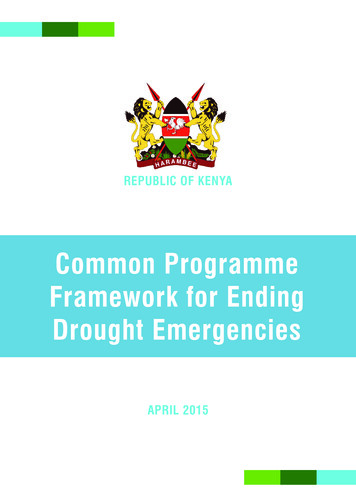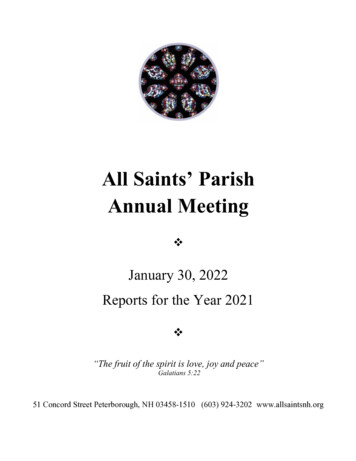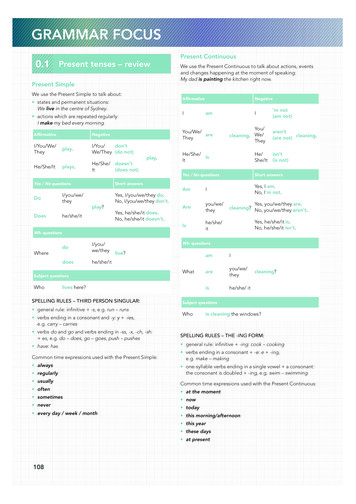
Transcription
REPUBLIC OF KENYACommon ProgrammeFramework for EndingDrought EmergenciesAPRIL 2015
i ContentsTable of contentsKey dataiiiAcronymsivAcknowledgementsviiStatement by the National GovernmentviiiStatement by the County GovernmentsixStatement by Development Partnersx1Introduction12Purpose, justification and lessons learned33Situation analysis53.1Drought and development in the ASALs of Kenya53.2Institutional challenges and opportunities74Programme framework94.1Overview94.2EDE pillar frameworks114.2.1Peace and security114.2.2Climate-proofed infrastructure114.2.3Human capital134.2.4Sustainable livelihoods134.2.5Drought risk management154.2.6Institutional development and knowledge management165Cross-cutting issues and inter-pillar linkages185.1Cross cutting issues185.2Inter-pillar linkages196Risk management217Monitoring and evaluation228Knowledge management249Institutional arrangements25
ii Contents9.1Core institutional framework259.2Partnerships2610Resources3011Pillar 1 – Peace and Security3212Pillar 2 – Climate-proofed Infrastructure4413Pillar 3 - Human Capital8014Pillar 4 – Sustainable Livelihoods10115Pillar 5 – Drought Risk Management11916Pillar 6 – Institutional Development and Knowledge Management142Annex 1 Results framework168Annex 2 Statement of Intent175Annex 3 Summary of the programme development process177
iii Key dataKey dataCOUNTRYKenyaTITLECommon Programme Framework for Ending Drought EmergenciesDURATIONJuly 2014 – June 2018 (phase one)FUNDS REQUIREDKshs. 167,636 millionOVERALL OUTCOMECommunities in drought-prone areas are more resilient to drought andother effects of climate change, and the impacts of drought are contained.EXPECTED RESULTS1.Effective response to peace and security threats in ASAL counties by astrengthened peace and security infrastructure.2.The deficit of climate-proofed productive infrastructure and itsmaintenance is identified, planned and progressively addressed in acoordinated and comprehensive manner at national, county and communitylevel.3.A more healthy, skilled, innovative, resourceful and motivated humancapital in the ASALs.4.Enhanced resilience of ASAL livelihoods to the effects of drought andclimate change.5.Institutions, mechanisms and capacities that build resilience to droughtand climate change developed and strengthened.6.Robust ASAL institutions exist and support EDE investment, policy andprogramming decisions, based on critical evidence generated by solidknowledge management systems.FOCUS AREA ANDPOPULATIONArid and semi-arid counties, approximately 15 million people (36% of thenational population)CONTACT DETAILSChief Executive OfficerNational Drought Management AuthorityP.O. Box ke
iv AcronymsAcronymsADRAlternative Dispute ResolutionARCAfrican Risk CapacityARISAnimal Resources Information SystemASALsArid and Semi-Arid LandsASDSAgricultural Sector Development StrategyASFASAL Stakeholder ForumAUAfrican UnionCAConservation AgricultureCAADPComprehensive Africa Agriculture Development ProgrammeCBOCommunity-Based OrganisationCBPPContagious Bovine Pleuro-PneumoniaCCAClimate Change AdaptationCCKCommunications Commission of KenyaCCPISPCounty Climate-Proofed Infrastructure Support ProgrammeCCPPContagious Caprine Pleuro-PneumoniaCCTConditional Cash TransferCDFConstituency Development FundCEWARNConflict Early Warning and Response MechanismCEWERUConflict Early Warning and Response UnitCFACash for AssetsCGIARConsultative Group on International Agricultural ResearchCHUCommunity Health UnitCIDPCounty Integrated Development PlanCLTSCommunity-Led Total SanitationCMDRRCommunity Managed Drought Risk ReductionCoBRACommunity Based Resilience AnalysisCPDContinuing Professional DevelopmentCSGCounty Steering GroupCSOCivil Society OrganisationCSPConflict-Sensitive ProgrammingDDCDrylands Development CentreDLCIDrylands Learning and Capacity Building InitiativeDPCDistrict Peace CommitteeDRMDrought Risk ManagementDRRDrought Risk ReductionEACEast African CommunityECDEarly Childhood DevelopmentEDEEnding Drought EmergenciesEFAEducation for AllEMISEducation Management Information SystemEWSEarly Warning SystemFAOFood and Agriculture OrganisationFFAFood for AssetsFMDFoot and Mouth Disease
v AcronymsFPEFree Primary EducationGAPGood Agricultural PracticeGDPGross Domestic ProductGERGross Enrolment RateHDIHuman Development IndexHFAHyogo Framework for ActionHGSMPHome-Grown School Meals ProgrammeHMISHealth Management Information SystemHNRMHolistic Natural Resource ManagementHRHHuman Resources for HealthHSNPHunger Safety Net ProgrammeICTInformation and Communication TechnologyIDDRSIIGAD Drought Disaster Resilience and Sustainability InitiativeIDPsInternally Displaced PersonsIDSInstitute for Development StudiesIIEDInternational Institute for Environment and DevelopmentIGADInter-governmental Authority on DevelopmentILRIInternational Livestock Research InstituteIPARInstitute of Policy Analysis and ResearchKARIKenya Agricultural Research InstituteKCAKenya Census of AgricultureKDHSKenya Demographic and Health SurveyKeNHAKenya National Highways AuthorityKeRRAKenya Rural Roads AuthorityKESSPKenya Education Sector Support ProgrammeKFSMKenya Food Security MeetingKFSSGKenya Food Security Steering GroupKIPPRAKenya Institute for Public Policy Research and AnalysisKNAPKenya National Action Plan on women, peace and securityKNBSKenya National Bureau of StatisticsKNFPKenya National Focal Point on Small Arms and Light WeaponsKPLCKenya Power and Lighting CompanyKPRKenya Police Reserves (now the National Police Reserves)KRBFKenya Roads Board FundKRDPKenya Rural Development ProgrammeLAPSSETLamu Port-South Sudan-Ethiopia Transport CorridorM&EMonitoring & EvaluationMDGsMillennium Development GoalsMISManagement Information SystemMoALFMinistry of Agriculture, Livestock and FisheriesMoESTMinistry of Education, Science and TechnologyMoHMinistry of HealthMTPMedium Term PlanMWMegawattNACONEKNational Council on Nomadic Education in KenyaNCCAPNational Climate Change Action PlanNCDNew Castle Disease
vi AcronymsNCEWERSNational Conflict Early Warning and Early Response SystemNDCFNational Drought Contingency FundNDMANational Drought Management AuthorityNEPADNew Partnership for Africa’s DevelopmentNERNet Enrolment RateNKIFNorthern Kenya Investment FundNoKETNorthern Kenya Education TrustNRMNatural Resource ManagementNSCNational Steering Committee on Peacebuilding and Conflict Management (now thePeacebuilding and Conflict Management Directorate)NSNPNational Safety Net ProgrammeO&MOperation and MaintenanceOCHAOffice for the Coordination of Humanitarian AffairsODAOfficial Development AssistanceODLOpen and Distance LearningORSOral Rehydration SaltsPDNAPost-Disaster Needs AssessmentPPGPastoralist Parliamentary GroupPPRPeste des Petits RuminantsPVPhotovoltaicREARural Electrification AuthorityREGLAPRegional Learning and Advocacy ProgrammeREPRural Electrification ProgrammeS&GSheep and goat (pox)SALWSmall Arms and Light WeaponsSDGSustainable Development GoalSFPSchool Feeding ProgrammeSPSocial ProtectionSRICSecurity, Research and Information CentreTJRCTruth, Justice and Reconciliation CommissionTSCTeachers Service CommissionUNDPUnited Nations Development ProgrammeUNICEFUnited Nations Children’s FundUNISDRUnited Nations International Strategy for Disaster ReductionVGsVoluntary Guidelines (on the Responsible Governance of Tenure of Land, Fisheriesand Forests in the Context of National Food Security)VSVPVeterinary Surgeons and Veterinary Para-ProfessionalsWASHWater, Sanitation and HygieneWESCOORDWater and Environmental Sanitation CoordinationWFPWorld Food ProgrammeWSBWater Service BoardWSPWater Service ProviderWSTFWater Services Trust FundWHOWorld Health Organisation
vii AcknowledgementsAcknowledgementsThis framework is the product of extensive discussion between the national and countygovernments and their development partners. The commitment of all involved, and thegoodwill and collaborative spirit shown throughout the process, are warmly appreciated. Thecontribution and support of the following are gratefully acknowledged:African Development BankAgence Française de DéveloppementASAL SecretariatASAL Stakeholder ForumCARE Kenya (representing the ASAL Alliance)Caroline KarwithaCGIAR Technical Consortium for Building Resilience inthe Horn of AfricaCharles SongokConcern (representing the ASAL Alliance)County Governments of Baringo, Embu, Garissa,Isiolo, Kajiado, Kilifi, Kitui, Kwale, Laikipia, Lamu,Makueni, Mandera, Marsabit, Meru, Narok, Nyeri,Samburu, Taita Taveta, Tana River, Tharaka Nithi,Turkana, Wajir and West PokotDepartment of Foreign Affairs and Trade, Governmentof AustraliaDepartment for International Development, UKGovernmentInternational Livestock Research Institute(representing the ASAL Stakeholder Forum)Julius NyangagaKenya Livestock Marketing CouncilKenya Rural Roads AuthorityMaendeleo ya Wanawake OrganisationMichael Ochieng Odhiambo / People, Land and RuralDevelopmentMinistry of Agriculture, Livestock and FisheriesMinistry of Devolution and PlanningMinistry of Education, Science and TechnologyMinistry of Environment, Water and NaturalResourcesMinistry of HealthMinistry of Interior and Coordination of NationalGovernmentNational Drought Management AuthorityNational TreasuryDrylands Learning and Capacity Building InitiativeSecurity Research and Information CentreEng. King’ori WathobioUnited Nations Development ProgrammeEuro Africa Consult Ltd.National Drought Management AuthorityEuropean Investment BankNational TreasuryEuropean UnionOxfam (representing the ASAL Alliance)European Union Humanitarian Aid and Civil ProtectiondepartmentSave the Children (representing the ASAL Alliance)Food and Agriculture OrganisationUnited Nations Children’s Fund (Kenya office)German Development CooperationGlobal Peace FoundationUnited Nations Children’s Fund (Regional Office forEastern and Southern Africa)Intergovernmental Authority on DevelopmentUnited Nations Development ProgrammeIGAD Resilience Analysis UnitUnited States Agency for International DevelopmentInternational Fund for Agricultural DevelopmentWorld BankInternational Institute of Rural ReconstructionWorld Food ProgrammeSecurity Research and Information Centre
viii Statement by the National GovernmentStatement by the National GovernmentDrought is the single most damaging natural hazardin Kenya, destroying lives and livelihoods andundermining national development. These impactsare likely to worsen with climate change. However,they could be significantly mitigated if adequateand appropriate measures were taken in advance,particularly those that strengthen people’s capacityto withstand periods of drought.The Constitution places on the state obligations toprotect the vulnerable and progressively realise aportfolio of rights, including the right to be free fromhunger. It is with this in mind that the Governmenthas committed itself to ending drought emergenciesin Kenya by 2022. This commitment is clearly speltout in the Second Medium Term Plan (MTP) for theVision 2030, in which Ending Drought Emergencies(EDE) is recognised as one of the key foundationsfor national development.The EDE initiative reflects two significant changes inour understanding of drought emergencies in Kenya.The first is that they have their roots in poverty andvulnerability, and in the fact that Kenya’s droughtprone areas are among those which have benefitedleast from past investment; drought emergencieswill not end until the essential foundations fordevelopment (principally security, infrastructureand human capital) are in place. The second is thatdrought emergencies are complex challenges whichcan only be managed by strong and competentinstitutions, able to draw on new streams of financeas well as the skills and resources of all actors.ThisCommonProgrammeFrameworkoperationalises EDE commitments through anapproach that strengthens collaboration andsynergy across sectors, agencies and counties. Itsaim is to improve the coherence and efficiency ofinterventions and thus increase their impact on thelives of vulnerable people. It has been developedwith the full participation of the County Governmentsand our development partners. Its implementationwill be steered and supported by the NationalDrought Management Authority under the Ministryof Devolution and Planning.The Common Programme Framework for EDE is alsothe Government of Kenya’s contribution to IGAD’sDrought Disaster Resilience and SustainabilityInitiative. Risks are rarely confined within nationalborders, making regional collaboration an essentialpart of drought management. Kenya is committedto playing its full part in the wider struggle to enddrought emergencies across the Horn of Africa andbeyond.
ix Statement by the County GovernmentsStatement by the County GovernmentsDevolution provides an unprecedented opportunityto end the suffering caused by drought. Amongother things, devolved governance was introducedto bring services closer to citizens and to promoteequitable development that also protects therights of marginalised communities. Effective andaccountable investment and service delivery by theCounty Governments will make a critical contributionto drought management efforts in Kenya.The value of proximate service delivery has beenillustrated by the drought of 2014-15, when thegovernments in affected counties took active stepsto provide water, protect the health of livestock,scale up public health and nutrition services, andpromote peace. More strategically, devolutionis a means to address historical inequities inthe distribution of public resources and enablepreviously marginalised regions to develop in waysthat are more attuned to local priorities.Their proximity and accountability to affectedpopulations makes County Governments animportant first responder in any crisis. Moreover,risks are often highly localised, which means thatthose working within devolved structures are likelyto have a stronger understanding of needs onthe ground and of the interventions most likely toprotect communities at risk.In the two years since the County Governmentswere established, each drought-affected countyhas developed a drought contingency plan; severalof these plans have been activated as conditionsworsened. Some counties are establishing dedicatedfunds for disaster response or climate adaptation,while others are introducing policy and legislation toguide drought and disaster management. There arealso numerous initiatives to strengthen inter-countycollaboration and coordination, since the impacts ofdrought, and the interventions required to manageit, are unlikely to be contained within the boundariesof a single county.County Governments have been closely involvedin the development of the Common ProgrammeFramework for EDE and fully support its objectives.Several of the EDE pillars relate to functionswhich are now devolved (such as agricultureand health), and investments in these areas arebeing progressively absorbed within the CountyIntegrated Development Plans. However, the wholeframework requires the collaboration and goodwillof government at both the national and the countylevel, and between counties. We are committed toworking in ways which deepen this cooperation andthus deliver wider benefits for the people we serve.
x Statement by Development PartnersStatement by Development PartnersAs development partners committed to povertyreduction and economic growth in arid and semiarid counties of Kenya, we welcome this CommonProgramme Framework for EDE. We congratulate thegovernment on developing a coherent frameworkthat recognises the structural vulnerabilities ofthose living in these areas and articulates thepriorities around which we can align our support.For some years now we have recognised that the wayin which we work has not always led to the changeswe seek. Programmes and projects have tendedto be developed in isolation from each other, andnot always fully aligned with, or led by, Government.While their benefits may have been positive at thelocal level, they have often not been designed ordelivered on a scale which allows them to leveragesustainable, transformative impacts over time. Wetherefore welcome this common framework forprogramming, implementation and learning, andbelieve that it provides a mechanism to achievemuch greater impact on the lives of vulnerablepeople than if we each acted alone.We believe that drought emergencies can only besustainably addressed through a multi-sectoraland multi-agency approach in which our immediateresponse to repeated and predictable cycles ofdrought becomes an integral part of a longer-term strategy that progressively reduces people’svulnerability to drought over time. The CommonProgramme Framework for EDE provides amechanism to build these synergies, within whichwe are committed to working.The Common Programme Framework is an exampleof a framework for resilience which international andhumanitarian actors are adopting as an organisingconcept for food security, disaster risk reductionand adaptation to climate change. It serves asa model for the country, region, and globally, andcan be supported by donors under emerging globalplatforms such as the UN Secretary General’s ZeroHunger Initiative, the Sendai Framework for DisasterRisk Reduction and the UNFCCC climate changeagreements.We recognise the significant policy and institutionalreforms that have taken place in Kenya inrecent years, particularly the advent of devolvedgovernance. These reforms provide a strongenabling environment for drought risk managementand dryland development. Our assistance will beprovided in support of these reforms and of theinstitutions created to deliver them, so that thepositive direction in which Kenya is moving can besustained.
1Introduction“While droughts may be an unavoidablenatural phenomenon in the Horn of Africa,their impact can be mitigated by humanaction. Droughts need not, and should not,lead to famine and other disasters.”- NAIROBI STRATEGY, ARTICLE 71The 2010-11 crisis in the Horn of Africa provedto be a turning point in drought management.It generated a commitment from governmentsand their partners not just to improve their futureresponse once drought arises but to address thechallenge of growing vulnerability. This emphasis onthe structural causes of drought emergencies is theprincipal point of departure from previous droughtmanagement efforts in Kenya.In terms of both rainfall and the distribution ofdamages and losses, the drought of 2010-11was less severe than that of 2009.2 However, itbrought into sharp relief the chronic vulnerabilityof people in Kenya’s arid and semi-arid lands(ASALs), particularly when exposed to multiple andsimultaneous shocks (in this case drought, inflationand conflict), and the weaknesses of the institutionstasked with protecting them.The Summit of Heads of State and Governmentin September 2011 coined the phrase ‘EndingDrought Emergencies’ (EDE) to capture a newsense of purpose. The paper presented there bythe Government of Kenya signalled an importantshift in policy, from one that relies on reacting to theeffects of droughts as they arise, to one that activelyseeks to reduce vulnerability and risk throughsustainable development. This shift is based ontwo assumptions: first, that drought disasters arelargely avoidable, and second, that droughts arehaving a greater impact now than they did in thepast because underlying developmental challengesrelated to chronic poverty and inequality, insecurity,environmental pressures and climate change, arenot being adequately addressed.‘The Nairobi Strategy: Enhanced Partnership to EradicateDrought Emergencies’, adopted at the Summit on the Hornof Africa Crisis, Nairobi, 9 September 20111Republic of Kenya (2012) ‘Kenya Post-Disaster NeedsAssessment for the 2008-2011 Drought’.2
2 IntroductionThe paper presented at the 2011 Summit hasgradually evolved and deepened into a strategythat has been approved by the Cabinet, embeddedwithin the national development plan (Kenya Vision2030), adopted by key parts of both the nationaland the county governments, integrated withinIGAD’s broader regional strategy for resilience, andendorsed by development partners as a frameworkaround which to align their assistance.Finally, the common programming approach is fullyaligned with the various international commitmentsgoverning development cooperation and withKenya’s External Resources Policy of October 2013,specifically its requirements with regard to countryownership and leadership, mutual accountability,managing for development results, and strongeralignment and coordination of Official DevelopmentAssistance (ODA).The Common Programme Framework to EndDrought Emergencies is the product of a series ofdiscussions between the Government of Kenya andits development partners which took place betweenOctober 2013 and August 2014.3 (Annex 3 containsa summary of the process.) It represents the firstphase of a ten-year programme to end droughtemergencies by 2022. The Framework has threeareas of emphasis: eliminating the conditions thatperpetuate vulnerability, enhancing the productivepotential of the region, and strengtheninginstitutional capacity for effective risk management.The EDE Common Programme Framework focuseson the 23 most drought-prone counties in Kenya.Its implementation will be led by the relevantparts of the national and county governments,working in ways that strengthen synergy betweensectors and agencies and deepen accountability todrought-affected communities. Six complementarydocuments containing a detailed description ofeach pillar of the Framework are also available.4The Framework recognises the entitlementsand opportunities with regard to drought riskmanagement and development created by theConstitution of Kenya 2010. The Constitutionobliges the state to equalise opportunity, protectthe vulnerable, and progressively realise a portfolioof rights, including the right to be free from hunger.The content of the Framework is further rooted inthe analysis and priorities of Sessional Paper No. 8of 2012 on the National Policy for the SustainableDevelopment of Northern Kenya and other AridLands, and in the Vision 2030 DevelopmentStrategy for Northern Kenya and other Arid Lands.It is also consistent with, and will contribute to,the strategies for almost all the Medium TermExpenditure Framework sectors.At the international level, successful implementationof the Framework’s commitments will make asignificant contribution to Kenya’s achievementof global development goals. Negotiations areunderway to define a new set of sustainabledevelopment goals (SDGs) post-2015. The EDEFramework is well aligned with the content of thelatest draft, particularly the SDGs that concernending hunger, reducing inequality, and promotinghealthy lives, inclusive education, and resilientinfrastructure. It is also consistent with the SendaiFramework for Disaster Risk Reduction.The term ‘development partners’ in this context isunderstood to mean any organisation which has contributedto the process and is committed to working within theprinciples set out in the Statement of Intent (Annex 2).3The pillars are Peace and Security, Climate-ProofedInfrastructure, Human Capital, Sustainable Livelihoods,Drought Risk Management, and Institutional Developmentand Knowledge Management.4
2Purpose,justificationand lessonslearnedThe purpose of the EDE Common ProgrammeFramework is to facilitate cooperation and synergyacross sectors, actors, geographical areas andlevels of operation, so that programming is morecoherent, coordinated and efficient. A commonprogramming approach plays to the strengths ofdifferent agencies and instruments, and creates thepossibility of layering or aggregating interventionsthat target the same or different population groupsat different times and in different ways. The use ofcommon programming in drought management isalso an innovation on past practice.A multi-sectoral approach to sustainabledevelopment is particularly important in the ASALs,owing to a number of distinctive features includingremoteness, lack of infrastructure, and perennialdrought (Table 1).Strong multi-agency collaboration is also importantfor two particular reasons. First, the depth ofinequality between many ASAL counties and thenational average, particularly in access to basicinfrastructure and services, is such that only aconcerted and sustained effort over a long periodof time by a critical mass of partners can reduce it.(This inequality is illustrated in section 3.) Second,the ASALs are now the object of increasing state andprivate sector interest, driven by the discovery ofnew natural resources and by an appreciation thatthe region’s potential has been long overlooked. Thegrowing number and diversity of actors reinforcesthe need for mechanisms that coordinate theirinterests and efforts.In the specific context of risk management,common programming is a way of bridgingpreviously separate disciplines. The artificialdivide between ‘humanitarian’ and ‘development’practice has been shown to make little sensein a region where communities are dealing withmultiple and interlocking forms of disadvantage ona daily basis. Isolation, insecurity, weak economicintegration, comparatively limited political leverageand a challenging natural environment combineto produce high levels of vulnerability and chronicpoverty. When overlaid with the seasonal pressuresof drought stress, and the longer-term impacts ofclimate change on food security and nutrition,5 itACF-International (2014) ‘Who Cares about the Impact ofClimate Change on Hunger and Malnutrition?’5
4 Purpose, justification and lessons learnedis clear that the most appropriate and cost-effectiveapproach is one which attempts to understand andrespond to these unpredictable and inter-relatedrisks in a holistic and integrated manner.6 Such anapproach is now commonly conceptualised in termsof ‘resilience’ particularly, in the Horn and East Africa,since the 2011 Summit.7Finally, a common programming approach is especiallytimely in Kenya as the country is going through aperiod of major institutional reform, including thedevolution of authority to county governments. Whilethese reforms are moving in a positive direction, theyinevitably bring with them risks of fragmentationand inefficiency; there is also a tendency by newinstitutions to reinvent the wheel. A process thatbrings together the accumulated knowledge of manyactors and sets out a single, shared agenda for actionmay help ensure coherence and sustain progress ata time when the operating environment is more fluidthan usual.Table 1: Operating context in the ASALs 8CHARACTERISTICEXAMPLES OF IMPLICATIONS FOR POLICY AND PRACTICERELEVANCEA region remote fromthe centre, with limitedinfrastructure and services Incentives to attract investors and public servantsNorthern Kenya Strategies to strengthen national cohesion More conscious efforts with public information andextension Higher per capita cost of service deliveryA dispersed population,scattered across a large area in Alternative approaches to extension and communityrelatively small settlementsorganisation Northern Kenya Some semi-aridcounties Potential for technology to bridge distanceA mobile population, for whommobility is a rational responseto environmental conditions Innovation in service delivery Accommodation within the design of national projects(census, surveys, elections)All pastoralistcounties (14 out of23) Negotiation of cross-border mobilityA social system which placesa premium on communalpatterns of decision-makingand ownership, driven bycustomary institutions Decentralised management of land and natural resourcesAn arid environment vulnerableto drought and climate impacts Investment in risk reduction, social protection and Alternative or hybrid systems of justice Reconciliation of individual and group rightsadaptationAll pastoralistcounties (14 out of23)All ASALs Effective environmental and social impact assessmentsCabot Venton, C. et al (2012) ‘The Economics of Early Response and Resilience’; Fitzgibbon, C.(2012) ‘The Economics of Early Response and Resilience: Kenya Country Report’, London: DFID6Food Security Information Network (2013) ‘Resilience Measurement Principles: Toward anAgenda for Measurement Design’, Technical Series No. 17Source: Republic of Kenya (2012) ‘Vision 2030 Development Strategy for Northern Kenya andother Arid Lands’8
3.1 Drought and development inthe ASALs of Kenya3SituationanalysisDrought is one of the biggest threats to theachievement of Kenya Vision 2030. If unchecked,it can cause substantial damage and losses to thehealth and well-being of people and to the stabilityand growth of the nation. Table 2 illustrates thescale of recent droughts in terms of the numbersof people affected and the levels of humanitarianexpenditure. Between 2008 and 2011 the impactsof drought are estimated to have slowed GDP byan average of 2.8 per cent per annum, with totaldamage and losses estimated at US 12.1 billion.Further, the highest values of per capita damageand losses were in areas where the HumanDevelopment Index is lowest.9 Better managementof drought is therefore critical to human and nationaldevelopment.Droughts are clearly a national concern, but theirdirect impacts are most severe in the ASALs, wheredrought emergencies are a product of deepervulnerabilities. In semi-arid counties, the viabilityof marginal agriculture is threatened by populationgrowth, land pressure, climate change, differentattitudes towards farming among young people,and an over-dependence on rain-fed production ofvarieties which are poorly adapted to drylands. Inaddition, little of the value of agricultural productionis captured locally. In arid counties, prolonged underinvestment in public goods – the basic foundationsnecessary for development and growth, such assecurity, infrastructure, and healt
4.2.5 Drought risk management 15 4.2.6 Institutional development and knowledge management 16 5 Cross-cutting issues and inter-pillar linkages 18 5.1 Cross cutting issues 18 5.2 Inter-pillar linkages 19 6 Risk management 21 7 Monitoring and evaluation 22 8 Knowledge management 24 9 Institutional arrangements 25











